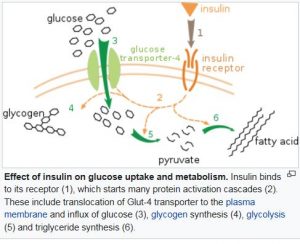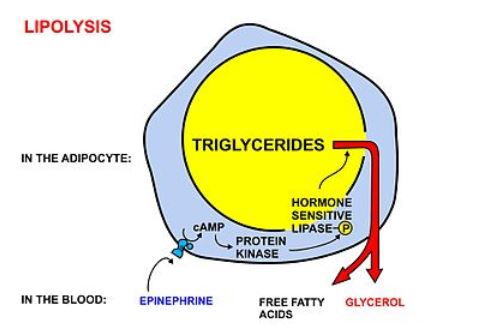The process
Your body loses fat when you create an environment in which it is not getting enough energy and must turn to fat stores to fuel all its functions. When a cell needs energy, a complex chemical process releases the fat from fat cells and converts it to usable fuel.
While all cells contain some fat, it is mainly stored in muscle (intramuscular triglycerides) and in adipose tissue (body fat), which is the body’s main fat storage. This is the fat we all want to lose.
Adipose tissue is divided into individual cells called adiposytes. These cells hold stored triglyceride (1 glycerol molecule bonded to 3 fatty acids) droplets. They serve as a source of energy for the body. These droplets are up to 95% of adipocytes’ volume. In order for this storage of potential energy (60,000-100,000 kcal) to be used and to lose body fat, it must be mobilized through lipolysis (the breakdown of triglycerides).
Lipolysis is the process of splitting the triglycerides into a glycerol molecule and 3 separate fatty acids (FFA). Once the fatty acids diffuse (exit) from the adipocytes, they bind to plasma albumin (a protein in the blood) in order to be transported to active tissues such as muscle. There they can be burned as an energy source.
This explains why you cannot “spot reduce” a specific area.
When triglycerides are broken down into the usable energy of glycerol and fatty acids, carbon dioxide and water are also released. You exhale the carbon dioxide and excrete the water in urine and sweat.
Insulin and Lipolysis

The fat stores in your body are metabolically active and dynamic tissues. There are two opposing processes that determine the amount of body fat. Lipogenesis is the process that converts sugars in to fats, which are subsequently deposited and stored in fat tissue. Lipolysis is the process of fat breakdown, typically to generate energy. These two metabolic activities are controlled by hormones secreted by your pancreas, pituitary and adrenal glands, and ovaries or testes. The pancreatic hormone insulin is particularly important in fat metabolism and lipolysis.
Insulin is secreted from pancreatic cells in response to rising levels of glucose in your bloodstream. The consumption of food — particularly proteins and carbohydrates — provokes the release of insulin from your pancreas. In contrast, fasting and a falling blood sugar reduce insulin production and its release. Insulin triggers the absorption of glucose by muscle, liver and fat cells, thereby lowering the blood sugar level. In addition, insulin stimulates the uptake of fatty acids by fat cells, which convert these molecules into triglycerides (the primary storage form of fat in your body). Thus, insulin triggers lipogenesis.
When you need more energy or your blood glucose level falls, the production of hormones that mobilize your energy stores begins to rise. These hormones — such as glucagon and adrenalin stimulate lipolysis, which involves the breakdown of triglycerides stored in your fat tissue. The fatty acids and glycerol molecules released by lipolysis are then metabolized to generate energy to meet your needs. The hormones that oppose insulin and stimulate lipolysis are called glucose counter-regulatory hormones.
The hormones that control lipolysis and lipogenesis do more than simply antagonize each other’s actions in fat tissue. Hormones that promote lipogenesis may actually interfere with the production or secretion of other hormones that stimulate lipolysis. For example, when your blood sugar level rises, insulin does not simply drive glucose into your cells. It also inhibits the secretion of the counter-regulatory pancreatic hormone glucagon. In this way, insulin not only promotes lipogenesis, it effectively prevents lipolysis.
However, there are various factors that contribute to lipolysis and insulin is only one of them. Dietary modifications and exercise are among the most important factors for accelerating lipolysis and weight loss.
References:
https://www.livestrong.com/article/383467-how-does-your-body-get-rid-of-fat/
https://www.newyou.ie/blog-new-you.php?title=turning-your-body-into-a-24-7-fat-burning-furnace&post=u95635
https://www.livestrong.com/article/31619-triglyceride-broken-down/
https://www.healthstatus.com/health_blog/body-fat-calculator-2/burning-fat-vs-burning-calories/
https://blog.myfitnesspal.com/how-target-your-heart-rate-get-into-the-fat-burning-zone/
https://health.howstuffworks.com/wellness/diet-fitness/weight-loss/lost-weight.htm
https://www.verywellfit.com/body-into-fat-burning-machine-1231548
https://en.wikipedia.org/wiki/Lipolysis
https://en.wikipedia.org/wiki/Insulin

Leave a Reply